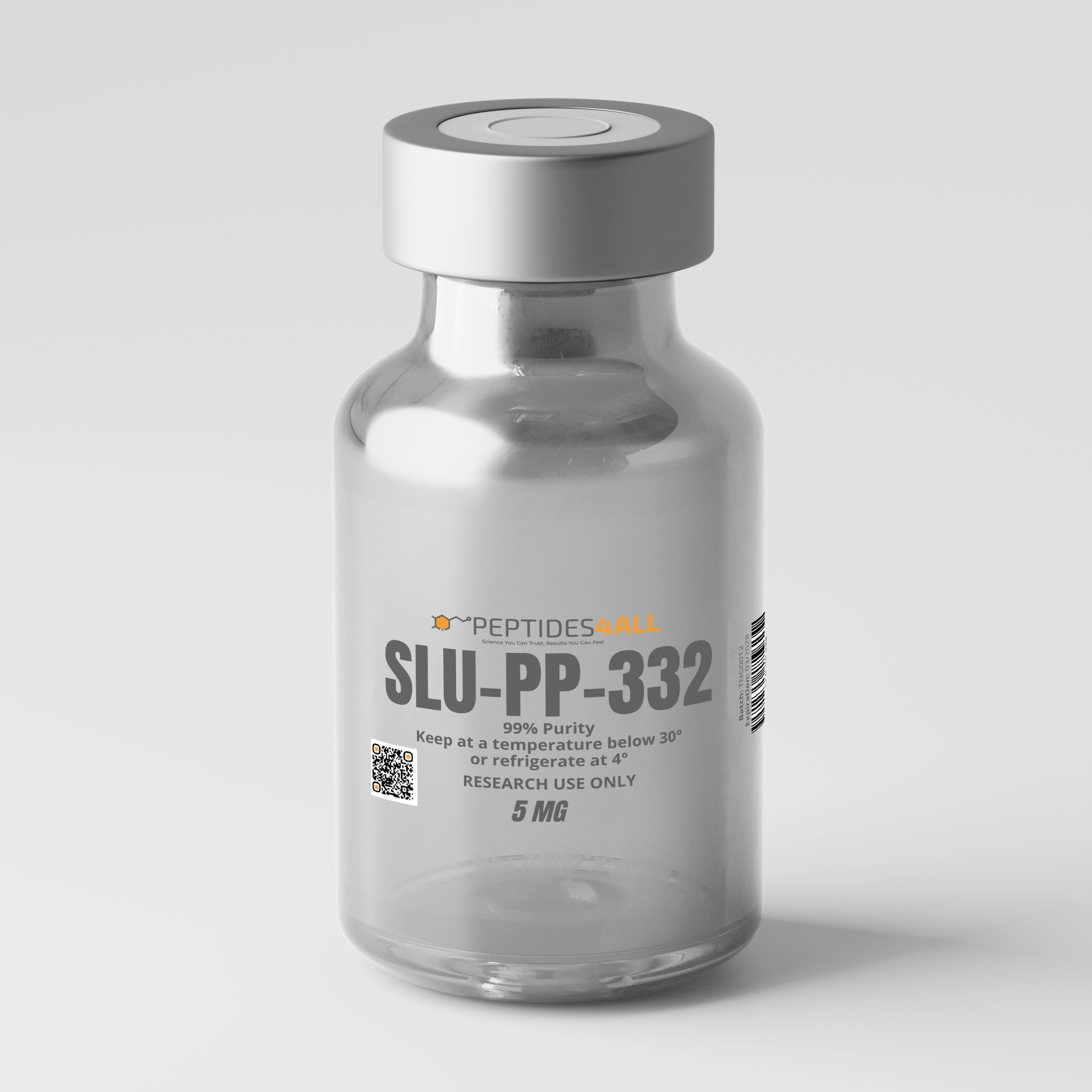PEPTIDES4ALL SLU-PP-332 – ERR Pan-Agonist for Mitochondrial & Metabolic Research
PEPTIDES4ALL SLU-PP-332 (also known as (E)-4-Hydroxy-N′-(naphthalen-2-ylmethylene)benzohydrazide or SR9861) is a synthetic small molecule that functions as a pan-agonist of the Estrogen-Related Receptors (ERRα, ERRβ, ERRγ)—a family of nuclear receptors that serve as master regulators of mitochondrial metabolism and energy homeostasis. Acting primarily through ERRα activation (EC₅₀ ≈ 98 nM) and secondarily via ERRβ and ERRγ, SLU-PP-332 orchestrates transcriptional programs that drive mitochondrial biogenesis, oxidative phosphorylation, fatty acid oxidation, and metabolic flexibility.
Because of its ability to mimic the molecular effects of endurance exercise, SLU-PP-332 is often described as an “exercise-mimetic” compound, providing a valuable model for studying mitochondrial activation, energy metabolism, and metabolic aging. By stimulating PGC-1α–dependent transcriptional networks, it enhances mitochondrial content and respiratory efficiency in skeletal muscle, liver, and other oxidative tissues (Nature Communications, 2018; PubMed 28356328).
Preclinical evidence suggests that ERR agonism via SLU-PP-332 reduces fat mass, improves glucose tolerance, and enhances insulin sensitivity, without requiring caloric restriction or exercise interventions (PubMed 31233143; PubMed 21750103). These effects are consistent with the compound’s role in reprogramming energy metabolism toward greater mitochondrial efficiency and lipid oxidation.
Beyond metabolic applications, SLU-PP-332 is being explored in aging and degenerative disease models, as ERR pathways have emerged as pivotal regulators of mitochondrial quality control, redox balance, and adaptive bioenergetics (PMC6354212). Its ability to enhance energy output at the cellular level while improving systemic metabolic parameters positions it as a promising research molecule for understanding exercise-like metabolic adaptation and mitochondrial resilience.
With its high-purity lyophilized formulation and well-characterized pharmacodynamic profile, PEPTIDES4ALL SLU-PP-332 provides researchers with a robust platform to investigate ERR-mediated transcription, mitochondrial regulation, and metabolic health, offering critical insights into the interplay between cellular energy systems, fat metabolism, and longevity signaling.
Scientific Evidence & Research Findings
-
Enhanced Mitochondrial Biogenesis & Respiration – ERR agonism promotes mitochondrial protein expression and oxidative metabolism in skeletal muscle. https://pubmed.ncbi.nlm.nih.gov/28356328/
-
Fat Mass Reduction & Metabolic Improvement – In diet-induced obese mice, ERRα activation was linked to reduced adiposity and improved systemic metabolism. https://pubmed.ncbi.nlm.nih.gov/31233143/
-
Improved Glucose Handling & Insulin Sensitivity – ERR activation has been shown to improve glucose tolerance and insulin signaling in metabolic disease models. https://pubmed.ncbi.nlm.nih.gov/21750103/
-
Exercise-Mimetic Gene Activation – SLU-PP-332 activates transcriptional networks overlapping with endurance exercise, including genes for oxidative metabolism and mitochondrial efficiency. https://www.nature.com/articles/s41467-018-03454-3
-
Potential Role in Aging & Disease Models – ERR pathways are being explored for therapeutic potential in aging, obesity, and metabolic syndrome due to their central role in mitochondrial function. https://pmc.ncbi.nlm.nih.gov/articles/PMC6354212/
Key Research Benefits & Applications
-
Mitochondrial Activation & Biogenesis: Stimulates PGC-1α–dependent transcriptional networks, increasing mitochondrial content, oxidative enzyme activity, and cellular respiration efficiency.
-
Exercise-Mimetic Metabolic Reprogramming: Replicates molecular adaptations of endurance exercise, enhancing fatty acid oxidation, ATP production, and metabolic flexibility without caloric restriction.
-
Improved Glucose & Lipid Metabolism: Enhances insulin sensitivity, glucose tolerance, and lipid utilization, reducing fat mass and supporting balanced energy expenditure.
-
Nuclear Receptor Modulation: Acts as a pan-agonist of ERRα/β/γ, coordinating systemic energy metabolism, mitochondrial quality control, and redox homeostasis across tissues.
-
Applications in Aging & Metabolic Research: Serves as a model for investigating mitochondrial decline, sarcopenia, metabolic syndrome, and age-related energy dysregulation.
-
Integrative Systems Biology Tool: Provides a research platform for studying nuclear receptor cross-talk, bioenergetic adaptation, and transcriptional control of oxidative metabolism.
Presentation & Handling
- Form: Supplied as lyophilized peptide in sterile vial.
- Reconstitution: Use bacteriostatic water or 2% procaine; swirl gently (do not shake vigorously).
- Storage: Store at –20 °C, protected from light and moisture. After reconstitution, use according to research protocols and handle under sterile conditions.
Intended Use
For research purposes only. Must be handled in accordance with institutional protocols and ethical guidelines.
